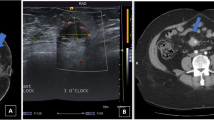Abstract
Purpose
This study evaluated the role of the correct diagnostic pathway through conventional imaging in evaluating breast disease.
Materials and methods
Six hundred patients aged between 35 and 75 years were enrolled in the study. All patients underwent detailed history and clinical examination, ultrasound (US) and mammography. US scans were repeated after mammography. All suspicious lesions were studied by cytological and histological characterisation and magnetic resonance (MR) imaging.
Results
The first US scan showed 147 solid lesions, 67 lesions characterised by posterior acoustic shadowing and 193 areas of heterogeneous echostructure. The second US scan, performed after mammography, confirmed 123/147 solid nodular lesions, 53/67 lesions characterised by posterior acoustic shadowing and 183/193 areas of heterogeneous echostructure; it also showed 13 nodular lesions not seen on the first scan and two cases of nodular lesions with irregular calcifications.
Conclusions
Our experience suggests that US not performed in conjunction with mammography gives rise to incorrect diagnostic interpretations (either false positive or false negative results). The detection rate of the US scan performed after mammography increases from 4.16% to5.5%.
Riassunto
Obiettivo
Scopo del nostro lavoro è stato valutare il ruolo del corretto iter diagnostico nell’imaging convenzionale nello studio della patologia mammaria.
Materiali e metodi
Sono state esaminate 600 pazienti (35–75 anni) sottoposte ad anamnesi, esame clinico, ecografia e mammografia. È stata effettuata successivamente una rivalutazione ecografica, alla luce della mammografia. Tutte le pazienti con lesioni sospette hanno proseguito il loro iter diagnostico mediante esame cito-istologico e/o risonanza magnetica.
Risultati
La prima ecografia ha documentato 147 lesioni nodulari solide, 67 casi di sbarramento del fascio ultrasonoro e 193 aree di disomogeneità ecostrutturale. Il secondo esame ecografico, eseguito successivamente alla mammografia, ha confermato 123/147 lesioni nodulari solide, 53/67 casi di sbarramento del fascio ultrasonoro e 183/193 aree di disomogeneità ecostrutturale. Sono state inoltre individuate 13 ulteriori lesioni nodulari non evidenziate alla preliminare ecografia ed in due casi abbiamo riscontrato la presenza di substrato nella sede del reperto mammografico di microcalcificazioni.
Conclusioni
Dal nostro studio è emerso che l’ecografia effettuata senza la possibilità di riscontro mammografico, ha dato luogo ad erronee interpretazioni diagnostiche intese sia come falsi positivi che come falsi negativi e secondo i nostri dati, qualora eseguita successivamente alla mammografia, ha consentito di incrementare il valore della detection rate dell’indagine ecografica da 4,16% a 5,5%.
Similar content being viewed by others
References/Bibliografia
Associazione Italiana Registri Tumori (AIRTUM) (2010) Sito dell’AIRTUM.http://www.registri-tumori.it (Cited January 2011)
Simonetti G, Cossu E (2001) Tecniche di immagine nella diagnostica mammaria. Trattato di ecografia in ostetricia e ginecologia. Poletto Editore, Gudo Visconti (MI)
Chan SW, Cheung PS, Chan S et al (2008) Benefit of ultrasonography in the detection of clinically and mammographically occult breast cancer. World J Surg 32:2593–2598
Flobbe K, Bosch AM, Kessels AG et al (2003) The additional diagnostic value of ultrasonography in the diagnosis of breast cancer. Arch Intern Med 163:1194–1199
Kimmick GG, Balducci L (2000) Breast cancer and aging. Clinical interactions. Hematol Oncol Clin North Am 14:213–234
Hatfield GP, Hogan MT (2009) The role of ultrasound in breast imaging. W V Med J 105:64–66
Chen JH, Huang CS, Chien KC et al (2009) Breast density analysis for whole breast ultrasound images. Med Phys 36:4933–4943
Baek SE, Kim MJ, Kim EK et al (2009) Effect of clinical information on diagnostic performance in breast sonography. J Ultrasound Med 28:1349–1956
Barr RG, Maldonado RL, Georgian-Smith D (2009) Comparison of conventional, compounding, computer enhancement, and compounding with computer enhancement in ultrasound imaging of the breast. Ultrasound 25:129–134
Di Maggio C, Del Favero C, Frigerio A et al (2004) Charta Senologica 2004. Approccio diagnostico alla patologia mammaria. Il Radiologo 1(Suppl):1–39
Berg WA, Blume JD, Cormack JB et al (2008) Combined screening with ultrasound and mammography vs mammography alone in women at elevated risk of breast cancer. JAMA 299:2151–2163
Chan SW, Cheung PS, Chan S et al (2008) Benefit of ultrasonography in the detection of clinically and mammographically occult breast cancer. World J Surg 32:2593–2598
Flobbe K, Bosch AM, Kessels AG, Beets L, Nelemans PJ, von Meyenfeldt MF, van Engelshoven JM (2003) The additional diagnostic value of ultrasonography in the diagnosis of breast cancer. Arch Intern Med 163:1194–1199
McCavert M, O’Donnell ME, Aroori S et al (2009) Ultrasound is a useful adjunct to mammography in the assessment of breast tumours in all patients. Int J Clin Pract 63:1589–1594
Chung SY, Moon WK, Choi JW et al (2010) Differentiation of benign from malignant nonpalpable breast masses: a comparison of computer-assisted quantification and visual assessment of lesion stiffness with the use of sonographic elastography. Acta Radiol 51:9–14
Zahl PH, Maehlen J (2010) Breast cancer mortality versus breast cancer survival. Tidsskr Nor Laegeforen 130:261
Izumori A, Takebe K, Sato A (2010) Ultrasound findings and histological features of ductal carcinoma in situ detected by ultrasound examination alone. Breast Cancer 17:136–141
Ballesio L, Maggi C, Savelli S et al (2007) Adjunctive diagnostic value of ultrasonography evaluation in patients with suspected ductal breast disease. Radiol Med 112:354–365
Nothacker M, Duda V, Hahn M et al (2009) Early detection of breast cancer: benefits and risks of supplemental breast ultrasound in asymptomatic women with mammographically dense breast tissue. A systematic review. BMC Cancer 9:335
Author information
Authors and Affiliations
Corresponding author
Rights and permissions
About this article
Cite this article
Pistolese, C.A., Perretta, T., Cossu, E. et al. Value of the correct diagnostic pathway through conventional imaging (mammography and ultrasound) in evaluating breast disease. Radiol med 116, 584–594 (2011). https://doi.org/10.1007/s11547-011-0657-x
Published:
Issue Date:
DOI: https://doi.org/10.1007/s11547-011-0657-x




